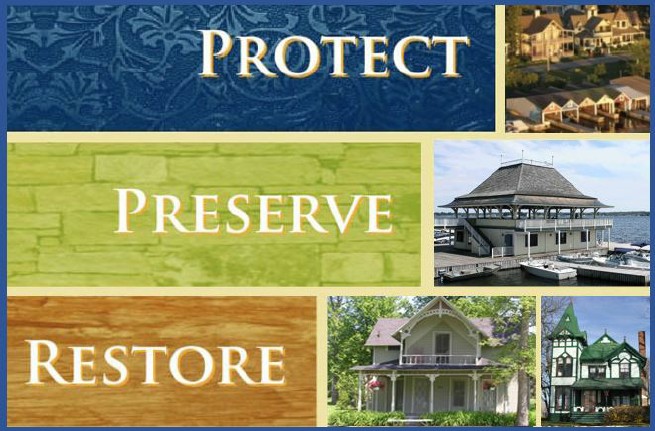"I'm thinking of a project for my cottage. What should I do?"
Thousand Island Park is operated by a privately-held corporation that
recognizes both our unusual historic past and our present as a very desirable
place to live - primarily in the summer. We have come to the Park because
we value the feeling of community, because we enjoy our neighbors and
because we recognize and appreciate this rare collection of architectural
gems.
With that as background, how should an improvement to a cottage be
approached? For most, the starting point is either a need for repair or
restoration, a desire to enhance their property, or a wish to accommodate a
Victorian structure to our modern society. And this may be the best place to
start the process - i.e. clearly defining what the desired change is and what
need is to be met.
For smaller scale projects, that beginning might be an owner-drafted "plan" or
a sketch by a friend or a potential builder. If the project is larger in scale, an
architect is probably warranted. At this early stage it is useful to consult the
Thousand Island Park Historic Preservation Handbook (available on our
website and at the Landmark shop) to become familiar with the Park's
Preservation Code and Land Use Regulations (see www.tiparkcorp.com).
The Landmark Society's Resource Library might also be a source of
inspiration and guidance.
It is useful to have an informal conversation with the TIP Corporation office,
both for inspiration and for a preliminary understanding of the review process
which, depending on the size and complexity of the project, may require an
application to the Preservation and Architectural Review Board (the
Preservation Board). Any exterior changes to your cottage, other than paint
color, must be submitted to the Preservation Board. The Preservation Board
review process itself will be the subject of a future "Preservation Blast."
The next step is often selection of a contractor. This should be done with an
architect if one is involved. The TIP Corporation has a list of contractors who
are approved to do work on the Park. Complete plans need to be drawn up
that explain the project and assist the review process - drafting plans may
also solidify and/or modify the envisioned project. Once plans are on paper a
firm cost can be ascertained and the review process, which will lead to a
clear project definition, a precise cost and a timeline, can begin.
We enjoy an extremely pleasant and rewarding "place on the River".
Engaging in projects to enhance each of our cottages adds to the architecture
and appearance of our community and improves our homes both individually
and collectively.
Sincerely,
The Preservation & Architectural Review Board
- and -
The Landmark Society
Thousand Island Park is operated by a privately-held corporation that
recognizes both our unusual historic past and our present as a very desirable
place to live - primarily in the summer. We have come to the Park because
we value the feeling of community, because we enjoy our neighbors and
because we recognize and appreciate this rare collection of architectural
gems.
With that as background, how should an improvement to a cottage be
approached? For most, the starting point is either a need for repair or
restoration, a desire to enhance their property, or a wish to accommodate a
Victorian structure to our modern society. And this may be the best place to
start the process - i.e. clearly defining what the desired change is and what
need is to be met.
For smaller scale projects, that beginning might be an owner-drafted "plan" or
a sketch by a friend or a potential builder. If the project is larger in scale, an
architect is probably warranted. At this early stage it is useful to consult the
Thousand Island Park Historic Preservation Handbook (available on our
website and at the Landmark shop) to become familiar with the Park's
Preservation Code and Land Use Regulations (see www.tiparkcorp.com).
The Landmark Society's Resource Library might also be a source of
inspiration and guidance.
It is useful to have an informal conversation with the TIP Corporation office,
both for inspiration and for a preliminary understanding of the review process
which, depending on the size and complexity of the project, may require an
application to the Preservation and Architectural Review Board (the
Preservation Board). Any exterior changes to your cottage, other than paint
color, must be submitted to the Preservation Board. The Preservation Board
review process itself will be the subject of a future "Preservation Blast."
The next step is often selection of a contractor. This should be done with an
architect if one is involved. The TIP Corporation has a list of contractors who
are approved to do work on the Park. Complete plans need to be drawn up
that explain the project and assist the review process - drafting plans may
also solidify and/or modify the envisioned project. Once plans are on paper a
firm cost can be ascertained and the review process, which will lead to a
clear project definition, a precise cost and a timeline, can begin.
We enjoy an extremely pleasant and rewarding "place on the River".
Engaging in projects to enhance each of our cottages adds to the architecture
and appearance of our community and improves our homes both individually
and collectively.
Sincerely,
The Preservation & Architectural Review Board
- and -
The Landmark Society


 RSS Feed
RSS Feed